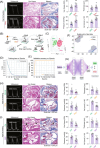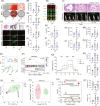Gut microbiota-derived butyric acid regulates calcific aortic valve disease pathogenesis by modulating GAPDH lactylation and butyrylation
- PMID: 40860435
- PMCID: PMC12371252
- DOI: 10.1002/imt2.70048
Gut microbiota-derived butyric acid regulates calcific aortic valve disease pathogenesis by modulating GAPDH lactylation and butyrylation
Abstract
The involvement of gut microbiota in calcific aortic valve disease (CAVD) pathogenesis remains underexplored. Here, we provide evidence for a strong association between the gut microbiota and CAVD development. ApoE-/- mice were stratified into easy- and difficult- to calcify groups using neural network and cluster analyses, and subsequent faecal transplantation and dirty cage sharing experiments demonstrated that the microbiota from difficult-to-calcify mice significantly ameliorated CAVD. 16S rRNA sequencing revealed that reduced abundance of Faecalibacterium prausnitzii (F. prausnitzii) was significantly associated with increased calcification severity. Association analysis identified F. prausnitzii-derived butyric acid as a key anti-calcific metabolite. These findings were validated in a clinical cohort (25 CAVD patients vs. 25 controls), where serum butyric acid levels inversely correlated with disease severity. Functional experiments showed that butyric acid effectively hindered osteogenic differentiation in human aortic valve interstitial cells (hVICs) and attenuated CAVD progression in mice. Isotope labeling and 13C flux analyses confirmed that butyric acid produced in the intestine can reach heart tissue, where it reshapes glycolysis by specifically modifying GAPDH. Mechanistically, butyric acid-induced butyrylation (Kbu) at lysine 263 of GAPDH competitively inhibited lactylation (Kla) at the same site, thereby counteracting glycolysis-driven calcification. These findings uncover a novel mechanism through which F. prausnitzii and its metabolite butyric acid contribute to the preservation of valve function in CAVD, highlighting the gut microbiota-metabolite-glycolysis axis as a promising therapeutic target.
Keywords: butyric acid; butyrylation; calcific aortic valve calcification; glycolysis; lactylation.
© 2025 The Author(s). iMeta published by John Wiley & Sons Australia, Ltd on behalf of iMeta Science.
Conflict of interest statement
The authors declare no conflicts of interest.
Figures





References
-
- Small, Aeron M. , Yutzey Katherine E., Binstadt Bryce A., Voigts Key Kaitlin, Bouatia‐Naji Nabila, Milan David, Aikawa Elena, Otto Catherine M., and St. Hilaire Cynthia. 2024. “Unraveling the Mechanisms of Valvular Heart Disease to Identify Medical Therapy Targets: A Scientific Statement From the American Heart Association.” Circulation 150: e109–e128. 10.1161/CIR.0000000000001254 - DOI - PMC - PubMed
-
- Rutkovskiy, Arkady , Malashicheva Anna, Sullivan Gareth, Bogdanova Maria, Kostareva Anna, Stensløkken Kåre‐Olav, Fiane Arnt, and Vaage Jarle. 2017. “Valve Interstitial Cells: The Key to Understanding the Pathophysiology of Heart Valve Calcification.” Journal of the American Heart Association 6: e006339. 10.1161/jaha.117.006339 - DOI - PMC - PubMed
-
- Huang, Yuming , Jiang Chen, Chen Liang, Han Juanjuan, Liu Ming, Zhou Tingwen, Dong Nianguo, and Xu Kang. 2023. “ Gli1 Promotes the Phenotypic Transformation of Valve Interstitial Cells Through Hedgehog Pathway Activation Exacerbating Calcific Aortic Valve Disease.” International Journal of Biological Sciences 19: 2053–2066. 10.7150/ijbs.74123 - DOI - PMC - PubMed
-
- Wang, Chunli , Huang Yuming, Liu Xianqiong, Li Lanqing, Xu Haiying, Dong Nianguo, and Xu Kang. 2021. “Andrographolide Ameliorates Aortic Valve Calcification by Regulation of Lipid Biosynthesis and Glycerolipid Metabolism Targeting MGLL Expression In vitro and In vivo .” Cell Calcium 100: 102495. 10.1016/j.ceca.2021.102495 - DOI - PubMed
LinkOut - more resources
Full Text Sources
Research Materials
Miscellaneous
